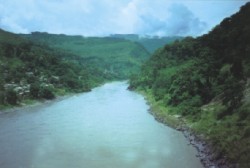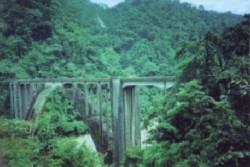|
A
Hilly Heaven Above the Sea
RAFIQ HASAN
It was a chilly, cloudy day
with the monsoon in full swing. The car crossed numerous
waterfalls flowing over the zigzag road leading to 14,000
feet above sea level. We passed amidst the continuous murmur
of springs and waterfalls coming from all sides. The car
was washed several times by the fountain waters. We were
in Sikkim, known as the the Switzerland of the east. Once
it was an independent Himalayan kingdom and now a tiny state
of India situated along the eastern border with China.
The
state is still a restricted area for foreigners. Foreigners,
other than Bangladeshis have to take permission from the
district magistrate office in Darjeeling before entering
into the state. For Bangladeshis, the permission is given
from India's foreign office in New Delhi. But there is no
problem in visiting Gangtok, the capital of Sikkim if you
can hide your original identity and identify yourself as
an Indian national.

Before the 60 kilometre long journey from
Gangtok to Baba Mandir everybody has to take clearance from
the Sikkim police submitting names and addresses and purpose
of the visit one day earlier. The hotel manager will arrange
the clearance from the Sikkim police but you will have to
face the Indian army yourself. They will intercept and ask
various questions to be sure about your nationality. One
is allowed to pass the area only after satisfying them.
In this case we were lucky, an army official
approached our car at the check post and asked various questions
to other passengers. There were two other couples in the
Indian made SUMMO TATA hired vehicle. We did not know each
other because the driver had picked us from our respective
hotels.
The couple sitting beside the driver in
the front seat gave their identities as residents coming
from Rajasthan. He showed the voter identity card and driving
license as the documents of his nationality. But the two
other couples including us did not have any such documents.
My wife and I were quite tense because if
they knew that we were from Bangladesh, they would definitely
not allow us to go to such a sensitive area. On the way,
we had observed Indian army personnel taking positions with
sophisticated arms like machine guns and cannon along the
border. Sitting silently, we were preparing what would be
the response if asked.
The army personnel also interrogated the
person sitting beside me. The person came from a district
in West Bengal. After that it was my turn. But the army
personnel suddenly went back to his higher officer and after
a few minutes gave the signal to pass the area without questioning
me.
I gave a sigh of relief. It was a great
victory for us because otherwise we would have missed the
chance of visiting the most exciting location in the state.
We had to hire extra winter clothes from
a shop on the way to go to Baba Mandir, situated over 14,000
feet above sea level. It is the last point in India. After
just a small hill, the Tibetan state in China begins.
The weather in Baba Mandir area was so cool
that our automatic camera did not function as the battery
went down. Thus we could not take any snap of the extreme
Indian border area even after overcoming so many difficulties.
The
small Baba Mandir was built in memory of an Indian soldier
who was killed during an operation in the area several years
back. The arms and outfit of the soldier Harbhajang Singh
were preserved there.

Army personnel particularly those who are
Shikh consider him a saint. Other than the beautifully decorated
wooden Mandir, the visitors also feel the thrill of observing
a water fall directly coming from China.
The area looks like a barren land as there is hardly any
human habitation within ten to fifteen kilometres area.
The sun is barely visible throughout the year as the weather
always remain cloudy. People in the area take a bath once
in a week or month.
On the way from Gangtok to Baba Mandir we
found natural fountains and water falls in almost every
corner of the road. There were also several springs or water
falls within one hundred yards.
A few hundred feet above the Baba Mandir
area, the Nathula border check post is located. The check
post remained closed since a war between India and China
during 60s.
Now the Indian government is considering
opening the check post. The Indian Prime Minister Atal Behari
Vajpayee recently visited Sikkim and declared that the check
post would be opened very soon.
The people in Sikkim are delighted as the
trade and commerce in the state would get a new boost after
opening the check post. They think that the route through
Sikkim is the nearest and easiest for opening a road link
with China.
“Opening up of Nathula will put the state
on the international trade map and encourage the people
to derive maximum benefits from it,” said governor of Sikkim
V Rama Rao in his independent day address.
Around 54 kilometres from Gangtok is Nathula;
the distance between Gangtok and Siliguri is only 114 kilometres.
Siliguri is connected with all major Indian cities by train,
road and air.
Around 2,000 feet down from the Baba Mandir,
is the famous Tsomgo lake 12,400 feet above sea level. Thousands
of people come from all over India to enjoy the beauty of
the lake and surrounding snow-capped mountains. The peak
seasons are October-November and March-April.
Various wild flowers blossom during the
winter, which is an added attraction for the tourists. The
day we visited the lake, wild yellow flowers in full blossom
in the surrounding areas enchanted us.
The temperature goes below zero degree during
winter and snow falls on the hill along the lake. The lake
is created by the crystal clear water coming from the rocky
hills in the surrounding areas. Water also flows down from
the hills located on the other side of the border.
There are many other places in Sikkim which
attract visitors. The visitors go to Pelling which is a
5 hour road journey from Gangtok, to see the Kanchanjangha
at close range. Kanchanjangha is also seen from a number
of points in Gangtok. The prominent point is Tashi viewpoint
from where the visitors can see the second highest Himalayan
peak clearly during winter.
The Gangtok valley is about 6,000 feet above
sea level. The city is clean and beautiful and green trees
and paddy fields cover the surrounding hills. People cultivate
paddy and vegetables on the slopes of the hills.
The Sikkimise live in wooden houses built
on the hill tops and their slopes. During winter, snow falls
on the green hill and wooden houses giving a view found
in Switzerland and many other European countries. White
clouds often roam around the hills creating superb scenarios.
This can be enjoyed even from the hotel rooms. On top of
the hill is a wildlife sanctuary which is still not completed
and has only about 12 species. The area designated for each
species is so large that it is difficult for a visitor to
spot an animal but you can still feel its presence.
The Ridge park in the heart of Gangtok town
though very small in size is rich in rare trees and orchids.
Seedlings and plants of Himalayan trees and orchids are
being preserved in a big greenhouse through artificial air
control. An entrance fee of five rupees allows the visitor
to enjoy them.
A number of beautiful Buddhist monasteries
most of them situated on the hilltops are another attraction.
The monasteries are beautifully decorated and built in Chinese
and Tibetan styles.
As we passed by the River Teesta coming
from Tibet and flowing through Sikkim we saw that the water
was crystal clear. The image of green hills and a meandering
blue river against the frosty skies remained with us long
after we left this piece of heaven.
|


